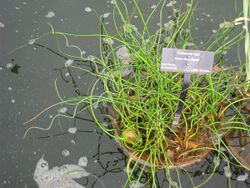Biology:Juncus effusus 'Spiralis'
| Juncus effusus 'Spiralis' | |
|---|---|
 | |
| Species | Juncus effusus |
| Cultivar | 'Spiralis' |
Juncus effusus 'Spiralis', the corkscrew rush (sometimes referred to as Juncus spiralis), is a perennial plant with green spiraling stems. It is a cultivar of the soft rush, Juncus effusus.
Description
The plants grow to 45 cm (18 in) high.[1] The young, leafless stems are light green and coiled, with the coils becoming looser with age.[2] They grow in both a horizontal and vertical direction. By winter, the stems become a yellow-brown or tan colour. Flowers are both rare and insignificant in terms of the plant’s appearance. They are yellow-green or light brown.[3]
Origin and name
The origin of the cultivar is uncertain, though Japan is thought to be a possibility. The cultivar has also been referred to as Juncus effusus f. spiralis and Scirpus lacustris 'Spiralis'. In the United States the cultivar is often confused with Juncus balticus 'Spiralis'.[4]
Cultivation
The cultivar is often grown as a novelty plant due to its unusual form. It prefers a situation in sun or partial shade and acidic soil.[5][6] Plants require permanent water, ideally between 5 and 10 cm deep, or continual irrigation. In-ground containers are sometimes used to contain spread. The cultivar is relatively free of pest or diseases, but is susceptible to drought stress.[7] The plants are maintained by the removal of old stems in spring.[6] In North America, they are able to be grown in USDA Hardiness Zones 4 and higher.[1][3] It is suited to container cultivation and can be used as a houseplant.[7][8] It can be grown on the edge of water bodies to help control erosion. Propagation is done by division of plants during the active growing phase of the plant.[6] Stems are used in floral arrangements. It can self-seed and become troublesome in some areas.
References
- ↑ 1.0 1.1 Nash, Helen; Steve Stroupe (2003). Complete Guide to Water Garden Plants. New York: Sterling Publishing Company. p. 195. ISBN 978-1-4027-0954-8.
- ↑ Aker, Scott (2005). Better Homes and Gardens New Garden Book. Des Moines, Iowa: Meredith Books. p. 496. ISBN 978-0-696-02557-0.
- ↑ 3.0 3.1 "Juncus effusus f. spiralis". Missouri Botanical Garden. http://www.mobot.org/gardeninghelp/plantfinder/plant.asp?code=V930.
- ↑ Speichert, C. Greg; Sue Speichert (2004). Encyclopedia of water garden plants. Portland: Timber Press. p. 204. ISBN 978-0-88192-625-5. https://archive.org/details/encyclopediawate00spei.
- ↑ Arnold, Michael A. (2006). "Juncus effusus 'Spiralis'". http://aggie-horticulture.tamu.edu/syllabi/608/Lists/second%20ed/JuncuseffususSpiralis.pdf.
- ↑ 6.0 6.1 6.2 "Juncus effusus f. spiralis". Royal Horticultural Society. http://apps.rhs.org.uk/plantselector/plant?plantid=1068.
- ↑ 7.0 7.1 Rogers, Ray; Rob Cardillo (2010). The encyclopedia of container plants : more than 500 outstanding choices for gardeners. Portland: Timber Press. ISBN 978-0-88192-962-1.
- ↑ Urban, Shelly. "corkscrew rush". Super Floral Retailing. http://www.superfloralretailing.com/june2008/pdf/FPOM_0608.pdf.
 |

